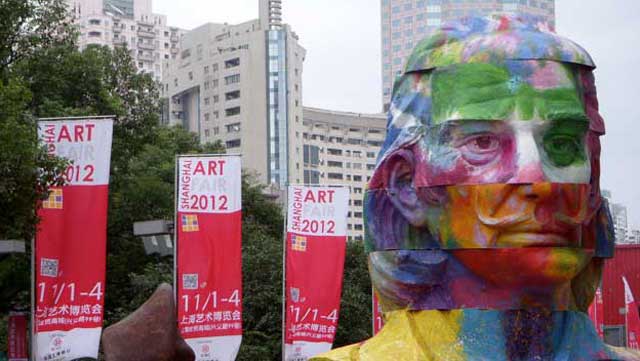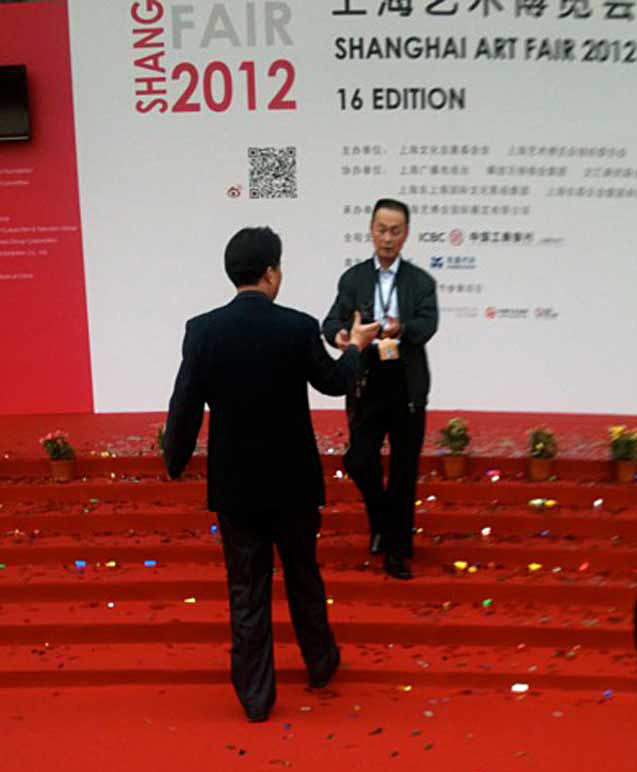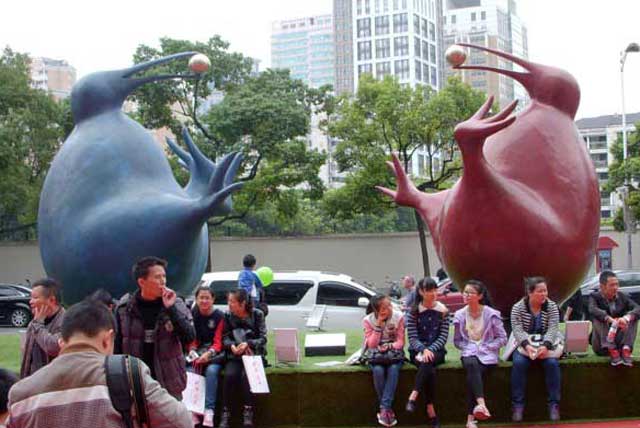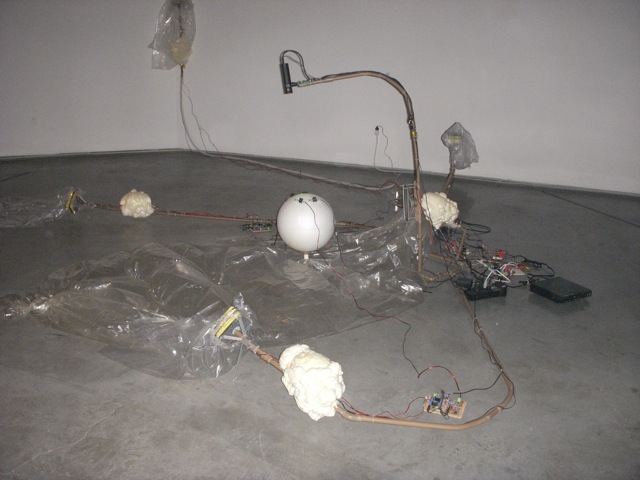Wednesday, November 7th, 2012
Leah Poller At 16th Annual
Shanghai Art Fair
November 2012

Shanghai Art Fair Entrance, 2012
Leah Poller
Dateline: Shanghai, November 6, 2012
A confetti strewn red carpet and the appropriate official lineup of government dignitaries ushered in the 16th Annual International Shanghai Art Fair (October 31-November 4, 2012) at the Shanghai Mart. A slowdown in the general economy, coupled with a recent crackdown on illicit valuations of art acquisitions on tax declarations may have dampened the marketplace, but from my perspective as a newcomer to the fair, it looked surprisingly healthy, with over 50 000 visitors. For established Asian artists, selling works 6 to 10 deep was considered business as usual on opening night, with a clear disparity in the lesser fortunes of “new to fair”, “new to Asia” and foreign talents who waited for the final hours to tally up their success.

Opening Ceremonies of the 16th Annual International Shanghai Art Fair
(October 31-November 4, 2012) at the Shanghai Mart
The big question to ask as an artist: Is this fair for me, or not?
First, the monumental scale of the country and its massive population is singular. Everything comparable feels smaller in comparison. Like the city map, where 1/2 inch = an hour trot at a brisk pace, the 4 x 4 inch program for the Shanghai Art Fair is a marvel of small print that barely suggests the participation of approximately 160 exhibitors and thousands of square meters of exhibition space. The Fair is divided into 4 categories on 4 floors: top tier/international, ancient/ceramic arts, emerging Chinese artists (government supported), and finally, the international/mixed/mid range, where, if you are reading this article, you most probably would be.
Attendance both at the opening and during each successive day was non-stop and voluminous. Well dressed and well heeled (I love those outrageous shoe fashions!), the burgeoning middle and upper class audience exhibited interest and patience in studying works up close. Shanghai shutterbugs – with the latest in obviously expensive photographic “neckwear”, incessantly took pictures. One of my sculptures attracted a snapshot almost every 3 minutes. More time is spent saying, “No pictures, please” than “Are you interested in knowing more about this work?”
In fact, the language barrier is the over-arching challenge. I found the inability to communicate, to translate ideas and values from one language to another, or to find a common ground on which to base an exchange of ideas or understandings quite painful. The vast majority does not speak English, plain and simple. A non-familiar iconography (abstraction, non-Asian subject matter, or contemporary Western style expression) is as much a challenge in visual translation as is the challenge of a linguistic translation.
Less than 1% of the visitors speak any English at all – repeat – any at all …so what you show… is what you show. No marketing embellishment, no glorious track records at auction, no taglines of enriching stories will help raise the level of engagement unless you have a highly qualified, Chinese origin, multi-lingual, art aficionado translator/sales person (a rarity).

Shanghai Art fair : Large Scale sculpture display
Add the inscrutable faces and there is not much you can do except wait to be approached with earnest interest. There is no note taking, no sign of desire and yet, come the weekend, the serious bargaining on second round visits is guaranteed. Work sells, consistently, surprisingly, and most non-Asian participants have no way to predict what works, what doesn’t. Corinna Steiner (Steiner Gallery, Vienna) said ”there was no way of knowing or predicting that a 25 year old visitor would select a work for $25 000 without any commentary.” With a final tally of $20 000 000/US in sales, this was undoubtedly happening often.
Without question, no matter what the origin of the artist, themes or references, leaning towards Asian sensitivities and cultural roots will help bridge the gap. The Chinese know their culture deeply and well. (Ex. Of the 7 sculptures I selected to exhibit, 4 had specific Asian references, 3 did not. The former were photographed constantly, and received enthusiastic smiles and “2 thumbs up”, while the latter were received indifferently).
Though the fair is international (45 galleries were foreign), the overwhelming presence is of galleries that are Chinese, or of mixed Asian/foreign ownership, or located elsewhere in Asia. Amongst the 200 exhibiting artists, about 90% were Asian or working in Asia, and the audience was visibly Asian. Sandy’s agitation of travel on the Eastern seaboard may have impacted the US presence of museums, critics, or galleries looking for exportable talent (apparently they flock to the Beijing fair) – but there was no way from my vantage point to confirm this. Do I believe they should be there…yes, and they will come. What is going on at the Shanghai Art Fair will gain ground so rapidly that heads will spin as this amazing marketplace (24 million inhabitants in Shanghai alone) joins the list of “must see” fairs for the global aficionados.
Rumor has it that Art Basel is in negotiations to purchase Shanghai Art. I trust they have crunched the numbers, even if the works offered fall far short of today’s international standard. And if this happens by next year (things move fast), then a replica of Beijing’s fair won’t be far behind. Discounting the free pass distribution to students and retirees (non buyers), the proportion of able buyers once again is not to be underestimated.
Overall, the artistic content reminds me of the early art fairs in the US. Safe, traditional paintings: still-life, landscapes, animals, and classic realism. For sculpture, figurines, oversized fruits or abstract drippy metal sculptures abound, while cutting edge, video, installation or avant-garde work just isn’t to be seen. That said, it wouldn’t be long till the full gamut of contemporary Western art is covered. Whoever risks getting into this burgeoning marketplace, with what chance for success, and at what cost, can be as arbitrary as the risk of participating in any other fair in the world. Except, “too late” may be just around the corner (Art Basel would assure that outcome).

Shanghart Gallery, Morgenshan Gallery District : Shanghai art fair – (most avant garde work)
The Asian artist Boun, the multilingual, multi-cultural nephew of a renowned Chinese artist, was decked out as a rare bird of paradise in rainbow allure, double rimmed, square, yellow spectacles and a plumed hat (the only “artsy” outfit I saw). Boun has done 9 successive Shanghai Art fairs. He has no problem selling expensive artwork at 10 – 15 pieces at a clip. Possessing the language, the culture, a leg up with business smarts, he was paired with Argentinean sculptor Beatriz Gerenstein (now based out of Miami) and once again, had blockbuster success “according to my own terms now”, Boun states. For Gerenstein “reaching the human emotion transcends the barriers of language”, and credits her success to the intuitive ability of the Chinese to recognize the authentic and sincere.
Dan Gerbo, a newcomer to Shanghai Art but otherwise a successful French entrepreneur with years of Asian business experience is taking a shot as a self- represented artist, who nonetheless felt abused by paying heftier transport costs from Shanghai to the Fair then from Paris to Shanghai. His work, totally outside the acceptable vernacular (nudes, geometric sculptures) is hoping for a pleasant surprise.
Denis Ribas, a type – A personality from the South of France, has traveled extensively with his art throughout Asia, and has sold more than 1800 paintings, since his beginning “on a lark” with the Hong Kong Artfair in 2000. He offers Raoul Dufy style, colorful familiar scenes with thick impasto and plenty of bravura.
Shanghai’s Purple Roof Gallery, founded by the mundane Peter Zhao is probably the rock star gallery of the Fair. Politically wired to the point of masterminding Jing’An, the first public, municipally financed international sculpture garden in Shanghai, Zhao has brought together a roster of world-class participants in the first inaugural event, soon to be followed by Part II. His next destination: Art Basel Miami to “shop for new artists.”
Julia Mao, director of the Jing’An project, who confides that it took enormous expense, effort and unimaginable collaboration in dealing with vetting by government committee, was not familiar with the US 1% program, but did mention that “plop” art in China is described as “the flower blossom that adorns the gravy portion of most traditional Chinese dishes.” Unquestionably, they are poised for the next big gesture in bringing international art to the Chinese public.
So how do you, as an artist, weigh the pros and cons of playing the Chinese card? It might depend on what you already have in your hand. First, don’t expect collaboration with other artists; it’s every man for himself here. Second, as a foreigner, you will fare better with a gallery representing mixed nationalities or with a geographic presence at home and in Asia. If you hit the lotto, you will hit it big. And what goes on here may not even matter to your home audience. You will get to travel far, learn a new culture, and grope your way through the new and under-explored to unearth the universal in your work. Not a path for the weak, fool hardy or short of vision dilettante.

Leah Poller - “Bed Pillow,” from the 101 Bed Collection, exhibited Shanghai Art Fair, 2012
The end result of venturing so far from home can be an unexpected combo of possibilities, which I experienced myself as a first time participant in the Shanghai Art Fair. It included front page billing in the catalogue, 2 major video interviews, thousands of photos of my work in circulation, a deepening relationship with my gallery, a financially advantageous relationship with a foundry capable of enlarging work to meet the demand expressed at the fair (represented in the US by a Rhode Islander who has been in Asia for 20 years), discussions of possible exhibitions in Chengdu, France, Shanghai, and Hong Kong, including the execution of a large scale work, and potential sponsorship for a public project.
Now the task is mine to bring these opportunities to fruition, and if I do, it will surpass anything offered to me Stateside…confirming that the definition of a genius is someone of talent far from home. Four days and possibly a life-changing moment…or not. There is something to be said for becoming the “rare-bird”, alighting in someone else’s far away garden. The hard work is only just beginning.
Leah Poller was born in Pennsylvania. She received classical training in sculpture at the prestigious Ecole Nationale Superieure de Beaux Arts, in Paris, France where she resided for 20 years. Partaking of a rich, multi-cultural environment, Poller interacted with foremost members of the international arts communities of France, Spain, Italy, Mexico and Latin America, through her art and from her collaboration on the facsimile re-edition of the major Twentieth Century Art Publications (Revolution Surrealiste, Dada, Cercle et Carre, Cobra, etc.). Returning to the United States in 1992, she established her studio in Soho and began the “The 101 Bed Collection” which has been exhibited in galleries and institutions in Europe, Mexico, Asia and throughout the United States. Her figurative work, notably ‘Women Warriors” and the newest series “Sung Heroes” unites the classical and the surreal with a uniquely modern reinvention of the portrait. She has been featured on CNN, Fox Television and in numerous art publications. She has lectured extensively and held workshops on creativity. In 2002, she was named Director of “Intercambios de Arte y Cultural Internacionale”, a Mexican/American association furthering cultural exchanges between the Americas and spearheading the restoration of a major twentieth century mural from 1935, recently discovered to be the work of Philip Guston. Poller lives and works in Harlem. www.leahpoller.com
The “101 BED COLLECTION” is a conceptual “oeuvre” of inter-related sculptures referencing common words with “bed” in them. While baroque, multi-layered and dense when examined individually, with each work acting as a mental jog to provoke an examination of our relationship to the bed, the whole is a provocative statement of “presence” of a largely ignored subject of intimacy and personal identification in the human landscape. Aesthetically connected to Judy Chicago’s “Dinner Party” by virtue of the complexity of its components, Poller’s “101 Bed Collection” is nonetheless an ambitious representation by a single artist. Triggered by an accident in her studio from which Poller was relegated to bed for an extended period of time, she began an extensive study of the bed in all its historic, cultural, aesthetic, visual, literary and narrative forms. While observing that more than a third of our lives are spent in bed, Poller is the rare artist to examine this icon extensively through a multi-faceted work of art, a 3 dimensional expression of her sense of humor, pathos, whimsy, sarcasm, tragedy and passion. Poller has invited a viral audience into a very personal theater of shared intimacy by creating the UNMADE BED PROJECT, a collection of photographs of unmade beds posted anonymously online from around the world, constituting the first anthropological/sociologic vision of this otherwise off limits and “absent” space (www.unmadebedproject.com).